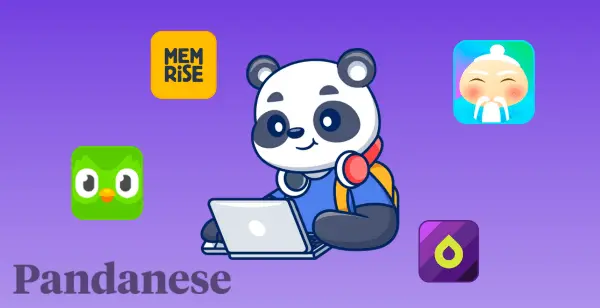
Need a Duolingo Chinese Alternative? Try These 4 Apps to Learn Chinese
With the most widely spoken language in the world, many people are eager to embark on the journey of learning Chinese.
Duolingo is undeniably one of the most common and popular language learning apps, but does it mean it is the best choice?
In this review, we will assess the effectiveness of Duolingo Chinese, explore its usefulness, and explore alternative language learning apps for studying Chinese.
What is Duolingo Chinese?

Duolingo Chinese’s learning interface | TechCrunch
Duolingo is a popular language learning application that provides lessons for multiple languages, including Chinese.
Its typical lesson approach exposes users to words, sounds, and characters without accompanying context, explanations, or sentences. Let's take a closer look at Duolingo Chinese.
Chinese Duolingo review

Duolingo Chinese sentence translation example | LingoDeer
Duolingo Chinese is an excellent resource for gaining a basic knowledge of the Chinese language. Users can quickly become familiar with certain phrases by learning characters, pronunciation, and tones.
Here are two main questions about Duolingo for Chinese:
Does Duolingo teach Chinese Characters? Yes, it can help you with simplified Chinese characters rather than traditional Chinese. There are matching games and forming words to help you memorize these characters. However, Duolingo Chinese does not give you a vocabulary list to refer back to.
Does Duolingo teach Chinese grammar? Yes. A typical Duolingo Chinese lesson introduces a small amount of vocabulary and gives you listening and speaking exercises, sentence building, and translating.
Duolingo Chinese is a great app for starting or those traveling or living in China, but probably not the best for long-term studying. It's a useful tool for reviewing the characters and grammar you've learned.
Is Duolingo actually good for learning Chinese?
Duolingo can be a great starting point for those learning Chinese. You will become familiar with simple phrases and basic sentence grammar.
Duolingo Chinese's speech-to-text pronunciation is pretty accurate. Its tip section has basic explanations of Chinese pinyin and grammar, but it's better to find an external source for a more in-depth explanation.
It seems that Duolingo's objective is for you to memorize vocabulary and basic sentences rather than build up your Chinese vocabulary from radicals and grammar explanations.
So, achieving Chinese fluency requires more than just this tool. Don't worry about searching. We got a list just for you.
Top 4 Duolingo Chinese alternatives to use
For more serious language learners, you've realized there is more than just Duolingo Chinese to learn Chinese.
Here, we give you 4 Duolingo Chinese alternatives—each with its advantages when mastering the Chinese language. Let’s take a closer look at these options in greater detail.
1. Pandanese

Pandanese's Mandarin for fruit
Pandanese is an online Chinese Hanzi learning platform that uses the SRS system and provides you with mnemonics to help you memorize Chinese characters faster. While it does not provide grammar rules, Pandanese is a valuable resource for building your Chinese vocabulary.
Learning Chinese characters with Pandanese is easy. They will give you mnemonics and fun stories to help you retain the meaning and pronunciation of each character. Once you've learned one character, the SRS system will retest you on the character. Get it wrong, and you will review the character again. Get it correct, and you will review that character later.
You can go into the settings for Pandanese to be more forgiving of any errors you make, especially if you mistype often. This setting is for the character's name, meaning, and reading. Additionally, if you have your own way of memorizing a certain Hanzi, you can customize the card as you see it.
2. HelloChinese

HelloChinese offers an effective solution for those looking to understand Chinese pronunciation and language better.
It is similar to Duolingo in terms of its learning pathway, by also providing you lessons, vocabulary definitions, and speaking lessons where you speak Chinese to repeat the phrase.
Unlike Duolingo, HelloChinese uses native speakers in videos to listen to, has additional lessons on a different topic, and provides you with grammar explanations and vocabulary translation. It also explains grammar, pinyin, and characters better than Duolingo in a more in-depth and simplified way.
Here is a quick overview of HelloChinese:
HelloChinese Overview by TeamTeacherChina3. Memrise

Memrise only shows pinyin or hanzi; not both at the same time | Memrise
When you combine Duolingo's learning pathway with HelloChinese extra features, you get Memrise.
It offers various Chinese courses with different topics, a vocabulary list for you to learn, grammar explanations, and pronunciation practices. Memrise combines tests, video clips, and individually tailored review plans to make your learning experience effective and beneficial.
Learning Chinese characters might be difficult as lessons don't combine Chinese hanzi and pinyin. This method makes learning Chinese characters and their pronunciation an extra step. Despite that, Memrise has useful phrases for you and a small grammar lesson.
This app is great for travelers and for anyone who wants to learn how to speak Chinese confidently.
Here is a very quick over of what Memrise can provide:
Quick overview of Memrise's Chinese lesson, TeamTeacherChina4. Drops

Drop’s Chinese interface | Drops
Drops is a little different from the rest of this list. It is visually different, has a nontraditional learning structure, has no strict learning path, and has a 5-minute time limit. The purpose of the time limit is to learn at your convenience to ensure you are learning for only 5 minutes. Hence the name, learning in small "drops."
However, unlike other apps, Drops also offers traditional Chinese and Cantonese. Take a look at that if you are interested in learning that.
Though be cautious. Its speech-to-voice text is a bit off where it will add an extra syllable or give slightly off pronunciation.
Drops are great for picking up vocabulary in small doses rather than focusing on reading comprehension and grammar.
Frequently asked questions
Is Duolingo Chinese Mandarin or Cantonese?
Duolingo offers courses in Mandarin and Cantonese.
Does Duolingo teach traditional or simplified Chinese?
Duolingo offers only courses for the simplified form of Chinese characters. Unfortunately, traditional Chinese script is not available on that platform.
What are some Duolingo Chinese alternative apps for try?
Pandanese, HelloChinese, Memrise, and Drops are great alternatives to try.
In closing
It’s important to understand the capabilities and limitations of each language-learning app or platform, including their approach to the Chinese writing system and Chinese tones, when you decide which one is best for your goal of mastering Chinese.
Duolingo Chinese offers a good base for those aspiring to achieve fluency in the Chinese language. But it’s important to recognize that you might struggle to master Chinese by solely relying on this app. So combining it with other tools such as Pandanese or Hello Chinese will help you in the long run—remember to keep going!
The easiest way to learn Chinese & build vocabulary

